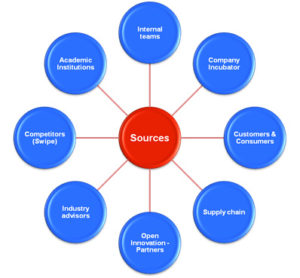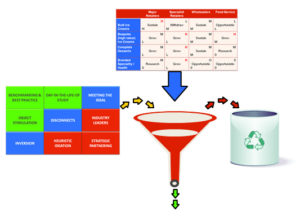Pipeline Management – It isn’t enough just to have a single idea in business. Very rarely do successful businesses survive and thrive upon a single business idea. Sure, that’s great for inventors but for a lasting business you need a steady stream of ideas, insights and innovative ideas. The Innovation Pipeline or funnel reflects the fact that ideas have to be generated, captured, organised, screened, prioritised and managed. Without a structured funnel of ideas people become disillusioned as they watch the wrong ideas being pursued and good ideas being steamrollered or ignored. Once your company has accepted innovation as a concept planned at strategic level you have to address the practical implications of an integrated innovation process.
So, taking the beginning of the pipeline (or funnel to be precise as it narrows as your ideas are worked upon) where do your best ideas come from? An effective starting point is to understand where innovations originate and how to collect and screen them. The most innovative companies automate this creative pipeline. Innovations and ideas can come from any part of a business. They can be a result of planned activities, such as focused innovation workshops and brainstorming sessions or from individual ideas stemming from discussions with customer ro suppliers, for example.

Internal brainstorming sessions focused on a particular business issue are sometime referred to as ‘skunk works’, and can result in highly innovative ideas for performance improvement etc. This all assumes you have the right people in the room and have created the right environment.
Idea generation is not the preserve of the R&D or marketing department. Nor is it merely limited to customer or employee ‘suggestion schemes’! The most innovative companies realise that everyone has a part to play. It is important that wherever ideas originate, they are collected, coordinated and managed as a valuable source of information central to the future of the business. The best companies map out where their best ideas come from and try to enhance the source. Some companies we have worked with talk about an ‘innovation war room’ where all ideas and innovations are collected and the management of them coordinated.

Clients who have engaged with us to create an Integrated Innovation Framework have adopted a more formal and proactive approach to the generation of new ideas and link them to the formal planning cycles within the business, namely:
The Annual Business Planning (ABP) process – typically done once a year as a result of a strategic review of the business. The output is usually a series of change projects and programmes many requiring a high degree of challenge and innovative thought.
Structured of ‘themed’ Focused Innovation Workshops (FIWs) – These are formally planned workshops designed to address a specific issue, usually in response to a crisis or opportunity that has arisen. Each of these workshops should be facilitated, focused and follow a structured agenda from creative thinking, to analysis and action planning. These FIWs can also be broken down as follows:
- Monthly Focused Innovation Workshops (FIWs)
- Market & Customer Insight (MCI) sessions (‘Voice of the Customer’)
- Internal Creativity Brainstorming sessions
- Online suggestion schemes
- Monthly Innovation Boards
Ad hoc day-to-day activities. This reflects the ideas generated whilst people carry out their daily routines in all functions of the business. The key here is to ensure that the current priorities of the business are communicated effectively and there is a method for capturing ideas as they occur. This is undoubtedly the most powerful form of idea generation in a business but relies on having a culture and environment that supports people coming up with new ideas at any and every turn!
No matter what approach you take, creating an Innovation Pipeline will:
- Ensure all ideas are aligned to your strategic goals
- Ensure effective prioritisation of ideas
- Grab any opportunities from planned or reactive business cycles
- Collate all ideas into a strategic database – an innovation portfolio
- Allow a comprehensive scoring system for ideas and insights
Create a Pipeline Buzz
The most innovative companies we have worked with also develop an ‘internal ideas market’ culture. Managers have budgets for innovations and get together to fund the implementation of new ideas, irrespective of where they originated. This is, in essence, an internal market for ideas, innovations and people. An organisation may take quite a while to achieve such a culture.
We at Innovation Leaders like to help companies with their idea generation schemes more than anything else! We run brainstorming sessions using our ‘creativity cube’ of idea generating techniques. We also run customer feedback initiatives as well as developing formal processes and events for idea generation. Think carefully about how you can create a ‘culture of innovation’ across the business. If leaders show an interest in people’s ideas and give support then your pipeline will come to life! This creates a buzz in the business which goes a long way to help generate an innovation portfolio.
External Sources of Ideas
In recent years the term “Open Innovation” has been adopted to reflect the fact that more ideas, thoughts and insights are stimulated outside of an organisation than within it! Working in partnership with third parties, customers, suppliers and independent innovators businesses with an effective ideas funnel can make huge gains in creating an effective business innovation pipeline.
The starting point for this is often referred to as ‘scanning’. It implies the systematic approach to the analysis and evaluation of ideas from outside the company. In companies that make this process work managers are allocated various roles for pulling information together and feeding it into a forum for review. Whilst external information is sometimes difficult to come by it is amazing how much can be gleaned from asking suppliers, customers, industry journals and trade bodies about the changes in the marketplace in general.
Lately there has been a trend to seek to solve customer issues and improve customer service by working in ‘partnership’ with other complementary organisations. Perhaps these might be businesses in other parts of the supply chain. Often customers are asked for their feedback not only on a product received or a service provided but on the logistics, distribution, packaging and other tangential elements. This is all about collecting information, which if done effectively and management well should result in innovations and improvements in customer service.
Lastly, a few organisations we have worked with, mostly in the Far East, use the term “Search & Development” (S&D) as a replacement for or complementary to “Research & Development” (R&D). The strategic aim here is to scan the marketplace, identify competitors and copy ideas often in a better, faster or cheaper way to innovate. Their aim is to build upon the ideas of others but add something of their own along the way. Whilst this might seem ethically dubious, as long as it is within the law and does not infringe upon IP (intellectual property) laws then this seems to work incredibly well for some sectors and businesses.
Whilst an effective innovation funnel seems quite a daunting prospect the simple starting point for all our clients is to list out where their best ideas came from and what did they do to replicate this? The biggest misunderstanding about innovation management is that people think that ideas, innovations and insights just ‘happen’! Nothing could be further from the truth. The most innovative companies we have worked with, around the word, work at generating ideas and innovations. They build upon insights had. They create databases of information and turn the so called ‘chance’ creation of an idea into a formalised business process. Once you have the pipeline created it is time to crank the handle and start filling up the ideas funnel.

